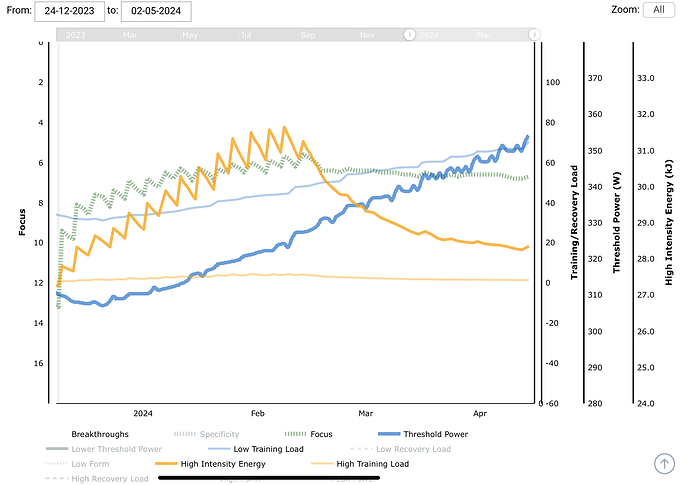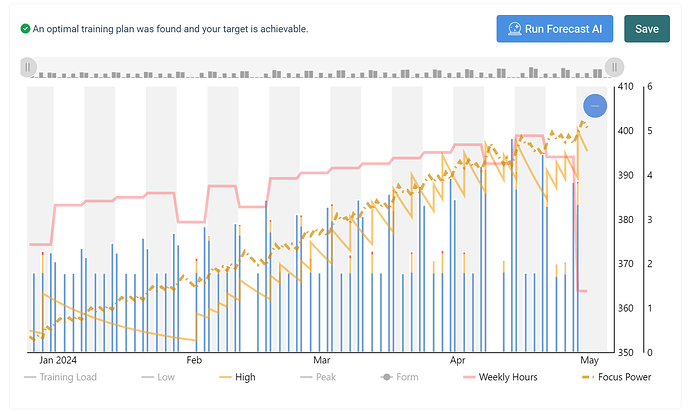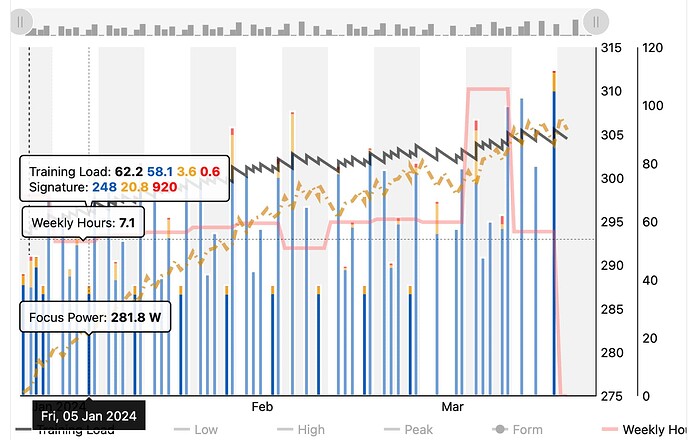Click on the watch icon below the forecast item in the planner. You can choose if you want to set the default for that weekday or if you want to set the value for that date.
Not sure where to post, but playing around and am not sure if the periodisation is working as intended?
- I have a climber / 10 min focus power goal at end April
- I seem to build high training to a peak of around 4 by the end of February (broadly in line with the goal high TL actually)
- and then reduce high load for the next 8 weeks to around 1.5… below that suggested when setting the goal
- this is despite literally every workout in the last 8 weeks being labeled ‘high intensity’… I am still building low training load during this time
Is that expected I.e. should it essentially overload and then ease over 8 weeks, as opposed to more traditionally building LTL first then brining HTL to a peak (with a short taper) just before the goal? Hard to see the HTL in the pic but you can see the effect on HIE
I also see my focus at the end is quite a bit shorter than 10 minutes - is that right?
And there is no taper - is that because I don’t use the event goal? If I’m hypothetically planning a segment PB on that day, I think I still want a short taper? Maybe not much taper is needed as the ride overall could be short (and Xert doesn’t know that, so can see why it’s not there I guess…)
The result looks quite ambitious to me - adding 50w of TP in 4 months… but I guess it’s an aggressive ramp rate over an extended period
Another observation is that despite setting an availability limit of 1.5 hours on Tuesday and Thursday, later in the plan i am allocated rides with more than 1.5 hour duration in those days? I may have a setting incorrect, but have tried both fixed and flexible and get longer workouts either way
Hi Wes,
I ran the main forecaster and I don’t get these results:
The results look really good. Base until Feb then a steady increase in high training load all the way until May. Looks like it’s honouring your availability all the way through.
When did you run fthe main forecast and did you also run Adapt afterwards?
Thanks, i ran it yesterday but did run a few adaptations after adjusting availabilities (first which days, then restricting weekday hours)… re-running the whole forecast, rather than ‘adapt’ seems to give better results (like you showed), also with the right focus and taking account of availabilities. Is the ‘adapt’ button meant to do something different to what I thought?
Yes we are trying to find the right balance for the Adapt function. It’s intended to be a quick operation to adapt to minor variations but it can run for more disruptive changes (like changing a day of the week availability) but it’s not well suited to these yet. It will likely see some improvements and/or restrictions on how it runs.
It could make sense to allow for a full reoptimization from the same UI if there are cases where that is recommended.
There is a very large difference in hours what I see on the planner vs what the training forecast says on my training page.
The forecast is showing for the next weeks starting in January I should be doing about 7 to 8 hours.
But if you look at the planner, the actual activities suggested are about 9.5-10.5 hours every week.
IDK which is right.
I think the graph on the top calculates stats for weeks starting on Sunday, not Monday. You can see when a week starts and ends by looking at the background color in the graph – gray or white.
The planner starts on Monday (based on your configuration).
One suggestion for the process of setting goals is to include maximum weekly hours (or XSS) and / or maximum ramp rate, and have the focus power be the result (kind of like the old way). Does that make sense?
Maybe I’m too bullish in my goals, but I fairly quickly need more hours than I have, so a slower ramp within the maximum would be better. I guess I can play around with less aggressive goals, but that’s then requiring multiple iterations… or I guess I could constrain my hours, but the way that’s implemented is a daily max, and the sum of my daily maximums could be more than I actually want to ride each week (e.g. I have 2 hours per day → 14 hours a week, but say I want to ride max 10 per week)… hope that makes sense.
For me, Sunday is a rest day so whichever way I configure the calendar I get the same hours each week. The issue is the planner shows 3+ more hours a week than the forecast is saying I need.
I mean, I like to ride and all but there are a LOT of 2.5-3 hour high intensity workouts on my planner still.
Sounds like a good idea to allow for some more user-defined constraints. Choosing the right constraints might require some experience/feedback, so maybe Xert should add this once it has been in operation for some time.
How much I am willing to ride also depends on the season. All riding will be indoors until mid-March, beginning of April. Then I will slowly start riding on the weekends, and after some more weeks, I will start doing some rides after work as well. I will not do too many 5-8 hour rides indoors, but happy to do that when the summer starts.
It is very time-consuming to set such constraints now, but it would make sense if you could a list of such constraint sets, each set valid from a certain date.
Yes agree, some seasonality of availability would be good eg during indoor season (to end March - but user defined) have X maximums per day / week, and then outdoor season would be Y maximums. Currently it would require defining each day / week separately which takes time over a 16 week plan. To simplify the implementation , instead of having the question of default yes / no, it could be ‘applies for next X weeks’ or until A certain date… so you could choose next 12 weeks for indoor door availability, then select a date in April to define availability for next 12 or 20 weeks. That could also be useful for planning holidays ( no need to change each day separately, but could plan next 2 weeks)
There are two sets of problems:
- How do you optimize a training outcome given constraints?
- How do you allow a user to input and manage all the constraints?
1 is what we’re aiming to achieve and is very challenging but 2 is another problem altogether more to do with user interactions rather than algorithms. If 2 goes wrong, then 1 has no chance. Hence, it may take more work to assign all the availabilities for now but working on 2 would just add another level of complexity that we can’t afford to handle atm. But your suggestions are duly noted.
Somethings we are seeing as priorities though include multiple event planning, accounting for periods of overreaching (such as during a training camp) and allowing a user/coach to preset training loads and fitness signatures, either because they are new and don’t have data or have invalid/missing data.
Thanks. Can see 1 and 2 are different and that you do need to get 1 working well first (and obviously what you’ve done is a big step forward).
Focusing on 1, my remaining doubt is around how you project signatures that are associated with training loads that are significantly beyond those seen for an athlete before. I think I’ve never been much beyond two stars but seem to respond reasonably well in the range of 1 to 2 stars… but projecting that same response out to 3 and 4 stars may be optimistic e.g. I hope you’re wrong but I’ll be surprised if I can hold my current 5 minute power for 10 minutes at the end of April, even if my TL gets to 70+ from current 35. I expect there to be some diminishing returns, which may well be visible in the data you have from other athletes, so my question is whether that is or should be reflected in projections?
I’m sure I will get fitter by following the plan that gets me to 70 TL, but you may disappoint users if their final signature is well below forecast… maybe even a disclaimer for cases such as mine that would be going well beyond past loads would be helpful
We actually err slightly on the low side. (shhh…) so most people will slightly overachieve but there are many other variables / data errors we can’t direct account for. All in all though there is a definite pattern that is quite stark for most athletes and should readily reflect outcomes.
I also agree this would be a useful feature to set before the AI generates the plan. I have club racing every Sunday and a regular on line Team Time Trial every Thursday. Setting these initially so the plan develops around those constraints would be great.
You can just add these as planned activities (try to get the correct XSS and focus type) to the calendar and the forecasted activity will be what you should do in addition. Most likely Xert will not schedule any additional work these days. If Xert schedules some extra work that you will not be able to do you can just change your availability for those days.
Don’t be afraid of running the forecast multiple times–even if it is a bit time-consuming. It will just reoptimize your plan based on the available/updated information.
Experiment. Do “what ifs”. You don’t need to save it afterwards but you’ll get a sense of what you can / cannot do and what the various levers you have control over affect.



